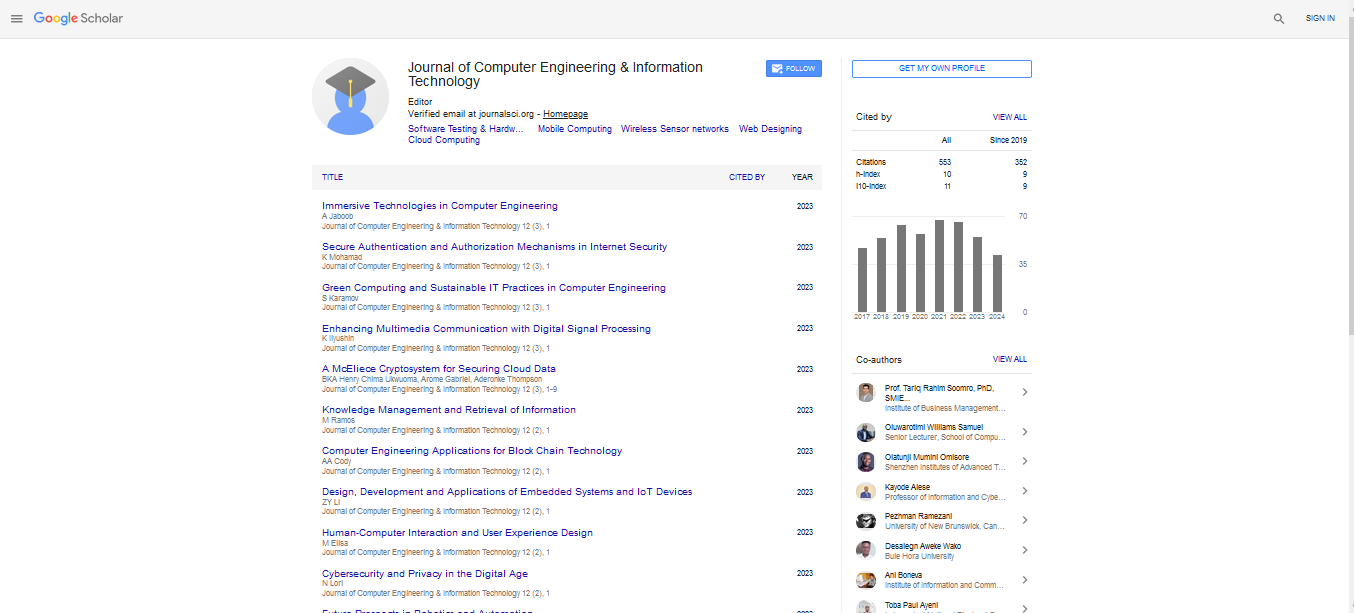Editorial, Jceit Vol: 14 Issue: 1
Cyber-Physical Systems: Bridging the Physical and Digital Worlds
Kemila Harris*
Department of Computer Science, Institute of Information Technology, UK
- *Corresponding Author:
- Kemila Harris
Department of Computer Science, Institute of Information Technology, UK
E-mail: harris_k@gmail.com
Received: 01-Jan-2025, Manuscript No. jceit-25-169306; Editor assigned: 4-Jan-2025, Pre-QC No. jceit-25-169306 (PQ); Reviewed: 20-Jan-2025, QC No jceit-25-169306; Revised: 27-Jan-2025, Manuscript No. jceit-25-169306 (R); Published: 31-Jan-2025, DOI: 10.4172/2324-9307.1000329
Citation: Kemila H (2025) Cyber-Physical Systems: Bridging the Physical and Digital Worlds. J Comput Eng Inf Technol 14: 329
Introduction
Cyber-Physical Systems (CPS) represent a transformative integration of computation, networking, and physical processes. By tightly coupling embedded computers and networks with physical entities, CPS enables real-time monitoring, control, and interaction between the digital and physical worlds [1]. These systems are foundational to many advanced technologies such as smart grids, autonomous vehicles, medical devices, and industrial automation, marking a significant leap towards the Internet of Things (IoT) and smart infrastructure.
What are Cyber-Physical Systems?
Cyber-Physical Systems combine embedded computing devices with physical components to form interconnected, coordinated systems. Unlike traditional embedded systems, CPS emphasizes the interaction between cyber (computational) and physical elements, enabling systems to sense, analyze, and respond to physical processes dynamically.
Key characteristics of CPS include:
Integration of Computation and Physical Processes: Real-time data from sensors influence computational decisions, which in turn affect physical actions [2].
Networking and Communication: Reliable, secure communication channels link distributed components.
Real-Time Operation: CPS operate under strict timing constraints to maintain system stability and performance.
Autonomy and Adaptivity: Systems can operate autonomously and adapt to changing environments or faults.
Components of Cyber-Physical Systems
A typical CPS architecture consists of:
Sensors and Actuators: Interface with the physical environment to collect data and effect changes.
Embedded Processors: Perform computation and decision-making tasks.
Communication Networks: Facilitate data exchange between distributed components.
Control Algorithms: Implement feedback loops to regulate physical processes.
Data Analytics and AI: Extract insights and optimize system behavior [3].
Applications of Cyber-Physical Systems
CPS are increasingly pervasive across various domains:
Smart Grids: Integrate renewable energy sources, optimize energy distribution, and enhance grid reliability.
Autonomous Vehicles: Real-time sensing and control enable safe navigation and coordination.
Healthcare Systems: Remote monitoring and smart medical devices improve patient care.
Industrial Automation: Intelligent manufacturing systems enhance efficiency and safety.
Smart Cities: CPS manage traffic, water supply, waste, and public safety systems.
Challenges and Future Trends
Despite their potential, CPS face several challenges:
Security and Privacy: Protecting interconnected systems from cyberattacks is critical [4].
System Complexity: Designing, verifying, and maintaining large-scale CPS can be difficult.
Interoperability: Ensuring seamless communication among heterogeneous devices.
Real-Time Constraints: Meeting stringent timing requirements under dynamic conditions.
Future trends point toward:
Edge and Fog Computing: Processing data closer to the source to reduce latency.
AI-Driven CPS: Leveraging machine learning for adaptive [5] and predictive capabilities.
Enhanced Security Frameworks: Robust methods to safeguard CPS integrity.
Standardization: Development of universal protocols and architectures.
Conclusion
Cyber-Physical Systems are at the heart of the next technological revolution, enabling intelligent interaction between computational and physical processes. Their applications promise enhanced efficiency, safety, and quality of life across numerous fields. Overcoming current challenges will unlock CPS’s full potential, paving the way for a deeply interconnected, smart, and responsive world.
References
- Rajkumar R, Lee I, Sha L, Stankovic J (2010) Cyber-physical systems: The next computing revolution. Design Automation Conference (DAC) 731â??736.
- Lee EA (2008) Cyber physical systems: Design challenges. 11th IEEE International Symposium on Object and Component-Oriented Real-Time Distributed Computing (ISORC) 363â??369.
- Gunes MH, Peter S, Lopes JP (2016) Cyber-Physical Systems: A Survey. arXiv preprint arXiv:1604.00345.
- Baheti R, Gill H (2011) Cyber-physical systems. The Impact of Control Technology 12: 161-166.
- Dutta P, Grewal R (2020) Cyber-Physical Systems: From Theory to Practice. Springer.
Indexed at, Google Scholar, Crossref
Indexed at, Google Scholar, Crossref
Indexed at, Google Scholar, Crossref
 Spanish
Spanish  Chinese
Chinese  Russian
Russian  German
German  French
French  Japanese
Japanese  Portuguese
Portuguese  Hindi
Hindi 